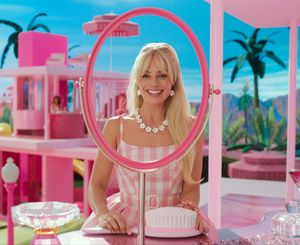I was not the first girl in school to own a Barbie. A few girls already had one before me, and had quickly formed a little can’t-sit-with-us cult. But thanks to a favourite NRI aunt, I soon had myself the tall doll as well as a matching salon set and bathtub. Within a week, I began to be invited to my class’s very elite club for Barbie parties and hair-colouring sessions (her platinum blonde hair could be streaked pink and purple).
Never mind, it would be just weeks before I would be back at my lonely corner in the library. I hated pink, and besides, the Secret Seven made for more interesting friends. I suspect the generation after me, obviously smarter than mine, was done with Barbie entirely.
Barbie Pink gave way to Bubblegum Pink and eventually, to Valentino Pink (their 2022 line is truly lovely, but second to Valentino Red). But that Gelusil-bright hue has been part of the fashion conversation once every decade or so. It is like a rash that keeps coming back. The last few times we devoured it, it was popularised on Jennifer Lopez, Paris Hilton and Britney Spears. Then some men decided to wear it to work and thankfully, gave us girls some respite from it for a few years.
Soon enough, with the growing number of homosexual boys coming out in public and embracing ‘girlie’ fashion—pink shirts, pink socks, pink feathers—it came to be decided that pink would not belong to girls and blue would not belong to boys. Modern would-be parents began painting their newborns’ rooms white or yellow. Fashion icon Victoria Beckham decided that her only daughter would not wear any pink, but a sea of dull English grey. And so she did.
But pink would never really go away. Blush, flush, old rose, and salmon were fine—but every time someone wore a pop of fuchsia, heads would turn. It almost became fetishist, we wanted our women to be dolls again.
But Greta Gerwig, the outstanding feminist filmmaker behind Lady Bird and Little Women, and who wrote Wes Andersen’s thought-provoking Isle of Dogs, is reclaiming Barbie again. She is turning the world’s most famous doll (sorry Paddington) on its head. Barbie and Ken are thrown out of Barbie Land for being less than perfect and sent into the ‘real world’.
The film’s phenomenal marketing is matching that of Mattel, the owner of the doll. The doll was first invented for girls to understand they could have careers (albeit they still needed zaftig breasts and perky glutes to get by). Mattel cleverly added a wardrobe, accessories, and sets for the dolls to be astronauts or hairdressers or doctors and such.
Now, that annoying psychedelic pink is back as Barbiecore. Hot pink has been spotted on Lizzo, Florence Pugh and, closer to home, on Deepika Padukone ever since Barbiecore began to trend in 2022, when pictures of lead actor Margot Robbie were released. The film’s announcement sparked a 416 per cent increase in searches for pink clothing, according to Time magazine.
Never mind whether we like the colour or not, Barbie made its founder Ruth Handler, a savvy businesswoman, very rich. The film will probably give Gerwig her first major hit. Barbie is like an old-girl’s version of Kim Kardashian’s Skims. Whether you believe women must have hourglass figures or not, the shape-wear brand is chasing $4 billion in pre-IPO funding.
@namratazakaria


